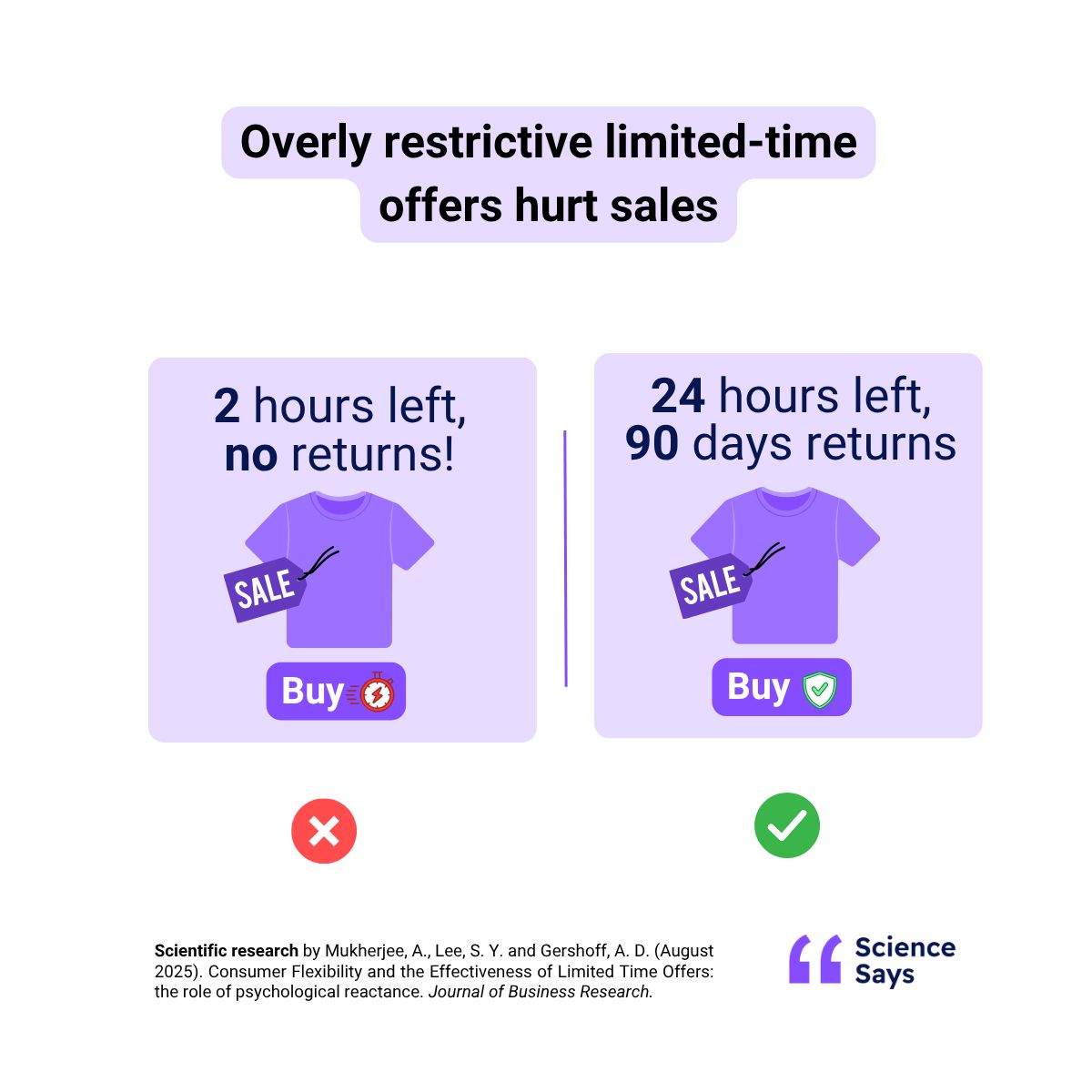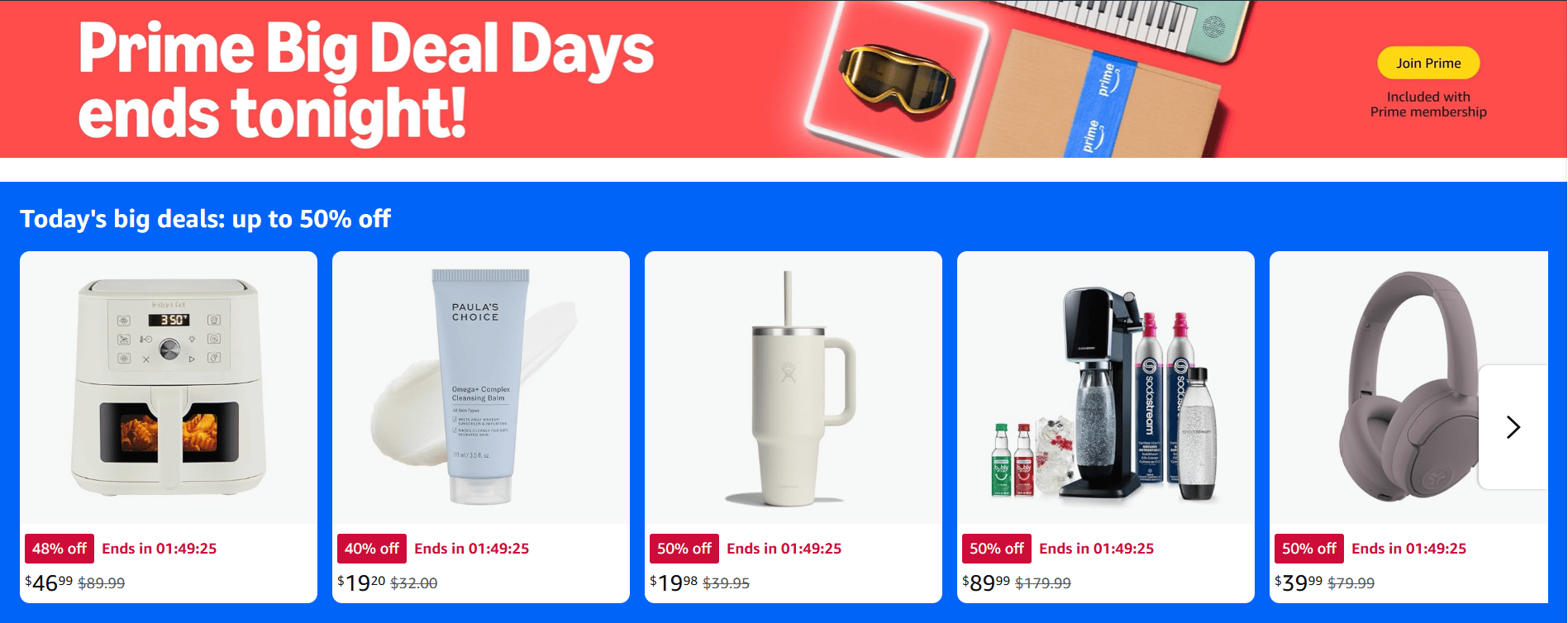- Science Says
- Posts
- Don’t over-restrict limited-time offers
Don’t over-restrict limited-time offers
Overly restricting limited time offers (e.g. too short time, strict refund limits) can reduce sales by up to 68%, compared to no offer at all. Try to keep them 1 day long.
📝 Context
Topic: Promotions | Customer Experience
For: B2C. Can be tested for B2B
Research date: August 2025
Universities: McGill University, Konkuk University, University of Texas at Austin
Your annual sale is coming up, and you want to offer a 30% discount to shoppers on your app and website. You had a high bounce rate previously, so you want to pile on the pressure so people buy immediately.
You’ve come up with 2 options on how to structure the sale:
Running a 2-hour sale, with no returns or exchanges
Running the sale for 1 full day, with your normal returns and exchange policy
As you’re debating which option seems more effective, here’s what the science says.
P.S.: You can also invent a special day as a reason for a limited-time promotion, like the anniversary of your company’s founding.
📈 Recommendation
When you’re running a limited-time promotion, avoid:
Very short time durations (e.g. 2.5 hours)
Stricter than usual return or exchange policies
Restrictive navigation on your site/app that prevents people from browsing other items
Try to keep your online promotion around 24 hours long, and include messaging about how people would regret missing the deal (e.g. “Don’t regret missing out!”). Make sure you include a justification for why the deal is only for a limited-time to avoid angering customers who miss out.
People will like the deal more and be more likely to buy.

🎓 Findings
People like and buy more during limited-time offers if they have a moderate time limit (e.g. 1 day). If there are too many restrictions (e.g. too short duration, no returns allowed, cart can’t include items not on sale), they’re less likely to buy.
As part of a series of 8 experiments, researchers found that compared to offers without a time limit, people:
Were 70.3% more likely to choose a limited time deal for a camera vs. a deal with no time limit when they had high flexibility to navigate across the site (e.g. people could browse the site, and were not restricted to a predetermined browsing path)
Spent 56.6% more at a charity campaign to buy chocolates when the deal was for 1 day and 68.3% less when the deal was only for 1 hour
Liked a spa package:
6.2% more when it had a 1-day time limit
7.2% worse when the deal was only for 1 hour
9.5% worse when the deal had a 1 minute limit
Limited-time offers are most effective when:
The website navigation is flexible, allowing people to easily move around the site. People were 33% less likely to choose a limited-time deal on a site with a rigid path of pages compared to a flexible site.
Coupled with a generous return policy (30 day returns). A limited-time offer led to 8.8% better judgments of a pair of headphones compared to an open-ended deal
People’s regret at missing the deal is highlighted. Saying “Buy now or regret it later” made people 18.6% more likely to buy a backpack with the limited-time deal vs. an open-ended deal.
🧠 Why it works
We experience psychological reactance, an urge to resist if we feel our freedom is being restricted or we’re being pressured.
1 day limits feel urgent but fair, so they don’t trigger this. 1 hour limits make us feel like we’re being rushed to choose, causing us to push back.
If a limited-time offer is coupled with other restrictions, it compounds our urge to push back, making us less likely to take the offer.
When a brand highlights the regret we’d feel if we don’t take the deal (e.g. “Don’t miss out on this opportunity”), it shifts our focus from the time limit and restrictions to trigger FOMO (our fear of missing out).
✋ Limitations
The study looked at 1 day long, 1 hour long and 1 minute long offers. Different categories have different definitions of what feels like a “reasonable” deadline (e.g. a 24 hour sale may seem ideal for fashion brands, but too short for a B2B SaaS platform). Other research looked at offers longer than 1 day and found shorter offers to be more effective.
The research focused on consumer goods (chocolates, electronics, and backpacks) and spa packages. It’s unclear if the effect is the same for everyday items (e.g. cleaning products, pantry staples), professional services or subscriptions.
Some people are more pressure-sensitive than others, making countdowns less effective for them.
👀 Real-life example
Amazon’s Prime Deal Days are run for a short time, with a countdown highlighting how long till the discount expires.

❌ Issue: Prime Big Deal Days are run for longer durations (48 hours), blunting the sense of urgency.
✅ Solution: Amazon can further optimize its Prime Big Deal Days by:
Reducing the time period, running the deals for 24 hours, instead of several days.
Adding a message to make customers feel they’ll regret missing the deal (e.g. “Don’t miss out on this opportunity”).
Including a justification for why the offer is for a limited time.
Displaying the original price ($4.52) before (to the left of) the discounted price ($2.31) to make the discount seem larger and make people more willing to buy.
Reversing how they frame the 48% discount, to say the price “was 95% higher” (which is mathematically equivalent).
🔍 Study type
Lab and online experiments and 2 field experiments (168 people at a Canadian university offered a deal to buy chocolates with various time limits and 270 people browsing a mock-up of an ecommerce website for electronics products with various restrictions and time limits).
📖 Research
Consumer flexibility and the effectiveness of limited time offers: the role of psychological reactance. Journal of Business Research (August 2025)
🏫 Researchers
Ashesh Mukherjee. McGill University
Seung Yun Lee. Konkuk University
Andrew D. Gershoff. University of Texas at Austin
Remember: This is a new scientific discovery. In the future it will probably be better understood and could even be proven wrong (that’s how science works). It may also not be generalizable to your situation. If it’s a risky change, always test it on a small scale before rolling it out widely.
🎁 Bonus mini-insight
Check your knowledge from previous insights (for paid Platform members only). Read the full insight here if you are already a member.
🎓 Insight: Promotions in italics are more effective
📈 Recommendation: When advertising promotions, discounts or sales, use italic fonts (slanted to the right) to increase the likelihood of sales and clicks and make the promotion more attractive.
✋ Careful: The text should be about a specific deal or promotion (e.g. “10% off storewide” or “Buy 2 shirts, get 1 free”), not a general announcement (e.g. “Winter Jackets Now In Stock”).